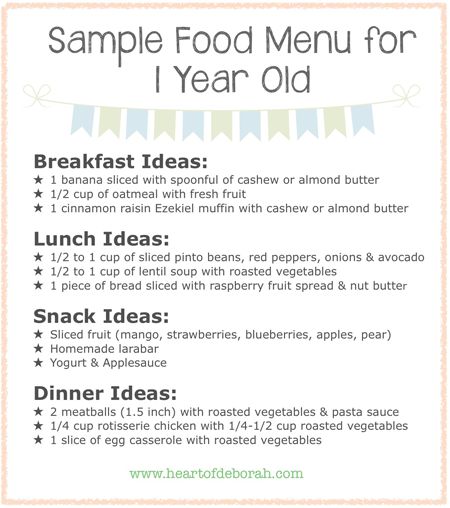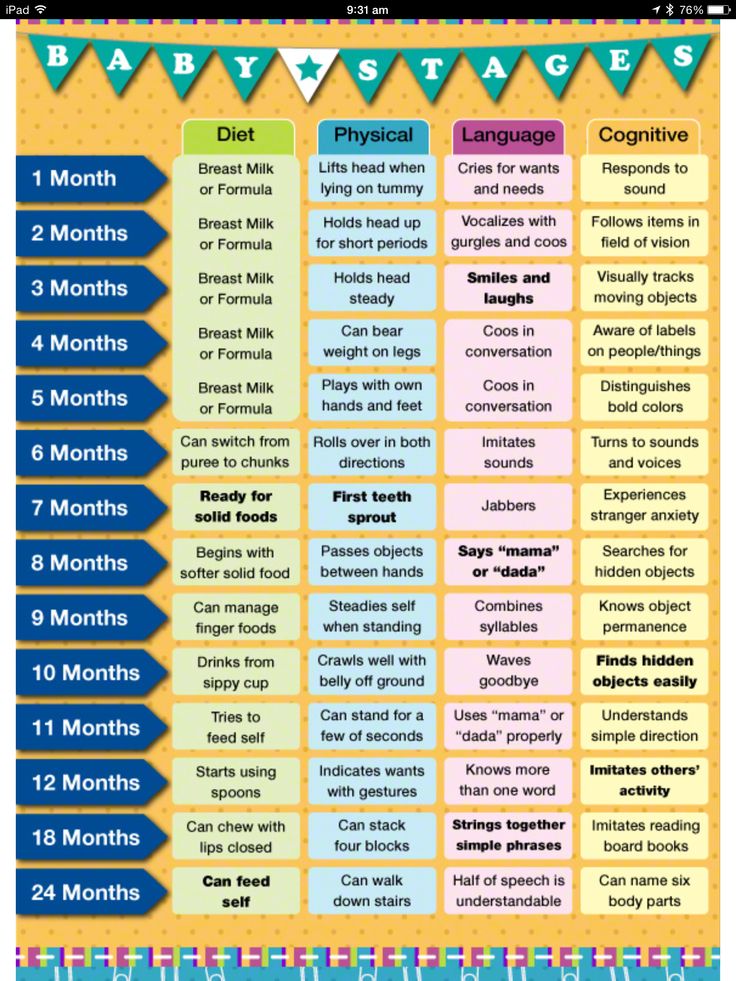Baby first food menu
6-9 Month Old Baby Food Puree Menu (FREE Printable)
Home » Recipes by Age » 6-9 Months » 6-9 Month Old Baby Food Puree Menu (FREE Printable)
This 6-9 Month Baby Food Menu brings new and exciting ideas to the table — literally! Know what to feed your baby for breakfast, lunch, and dinner using Stage 1 and Stage 2 baby foods. Plus, there is a free printable menu that you can use to map out your baby’s meals for the entire week!
Medically reviewed and co-written by Jamie Johnson, Registered Dietitian Nutritionist (RDN), and Lauren Braaten, Pediatric Occupational Therapist (OT).
6-9 Months Baby Food MenuAre you looking to plan your baby’s meals out for the week?
Then this meal plan is for you!
This easy-to-use meal plan guide featuring Stage 1 and Stage 2 Baby Food purees has month-to-month meal suggestions for your baby’s breakfast, lunch, and dinner.
I even included a free printable for you to print and fill out with what your baby will eat at each meal. It’s a convenient tool for use at home or to be sent to your daycare, grandparents, or caregiver’s house.
Is it your first time making homemade baby food? If you answered yes, then I suggest you start this journey by reading my in-depth Guide on How to Make Homemade Baby Food. The detailed article goes over all the essential information such as the best cooking tools to have on hand, safe storage, knowing when your baby is ready for solids, introducing purees, making the best first foods for baby, and more! You can also check out my best-selling cookbook for even more information and recipes.
How to Make Baby Food
Watch this video to see how easy it is to make your own baby food!
Frequently Asked Questions
When can baby eat purees?
When a baby can start on solids is determined by their own rate of development, which generally comes between 4-6 months of age. Some of the developmental milestones babies need to reach in order to start solids include: if your baby has solid control of their head and neck, if your baby has doubled in weight, and if your baby is reaching for or opening their mouth when you eat (see my guide here). Before you start baby on purees, you should consult with your pediatrician to make sure your child is developmentally ready.
Before you start baby on purees, you should consult with your pediatrician to make sure your child is developmentally ready.
How many ounces of purees should baby eat?
By the time baby is ready for finger foods, she should be eating around 4 ounces of food at each meal. If it is more or less than this, do not worry. Babies get most of their nutrition from formula or breast milk until they turn 1 year old.
Does baby need teeth to eat?
The question of how babies can chew foods without teeth makes any parent scratch their heads! But in reality, we all chew food with our back molars, not our front teeth, which baby doesn’t get until 18-22 months of age. Good thing babies have super tough and strong gums, which they use to mash, gnaw and chew foods. Baby’s gums are better at chewing food than you would think, and your baby will be able to chew more foods the older they get, even without their molars.
These tools will make it a lot easier to make homemade baby food purees. For more of my favorite kitchen tools make sure to check out my shop.
TOOLS NEEDED- blender or food processor
- baking sheet
- saucepans
- knives
- veggie peeler
- spatula
- freezer tray
- storage containers for fridge
- stasher bag
- reusable pouches
- baby food maker
- highchair
- suction bowl or baby bowl
- baby spoon
- open lid cup
- bib with catch pocket
- sleeved bib
- splat mat to cover the floor
2-3 Meals a Day
Aim to serve your baby 2 to 3 meals a day, and then add 2 more meals as your baby gets more comfortable with the eating process.
Start with a Small PortionStart by feeding your baby 1-2 ounces of a puree, and if they want more food, then, by all means, offer them more. However, if they turn their heads or clamp their mouths shut, take the food away and try again later.
However, if they turn their heads or clamp their mouths shut, take the food away and try again later.
You don’t want to try out new food or have mealtime when your baby is hungry. It’s best to feed your baby solid foods when they already had a little breastmilk or formula in their tummies but not when they’re too full either.
Breastmilk & FormulaBabies will continue to get most of their calories from breastmilk or formula until around one year of age. So don’t be stressed if it takes a little more time for your baby to develop their new eating skills. At this stage, feeding your baby solids is mostly for exposure and practice.
Serve a Wide Range of FoodsIt’s significant to serve babies assorted foods. Aim for lots of colors, textures, and flavors. Exposing your baby to various foods now will help them be comfortable with a wide range of foods down the road and help prevent picky eating.
It may take your baby up to 10 times of trying a certain recipe to decide if they like it or not. So remember to keep offering them that particular kind of food, even if they push it away the first 9 times you offer it.
Be PatientSome days your baby might eat everything you put in front of them, and other days, they might refuse to open their mouths. As challenging as it may be, you just have to increase your patience with them and follow their lead. Remember that each time you sit down for a meal together is a chance to work on new skills — how to sit on a high chair, hold (and drop) a spoon, reach out, grab a sippy cup, etc. So nothing is lost even if they don’t eat a single bite of food; they are still learning.
Get your FREE Printable HERE!Download
7 Month Menu OptionsAt 7 months, your baby’s expanded palate can probably tolerate thicker purees compared to last month. However, they should still be getting the majority of their calories from breastmilk or formula.
However, they should still be getting the majority of their calories from breastmilk or formula.
- Roasted Banana + Cinnamon Puree
- Apple, Raspberry + Vanilla Puree
- Banana, Blueberry + Avocado Puree
- Full Fat Plain Yogurt mixed with Banana, Cherry + Beet Puree
- Spinach Avocado Oatmeal Breakfast Cereal
- Spinach + Apple Puree
- Blackberry + Kale + Apple Puree
- Sweet Corn, Squash + Apple Puree
- Blueberry Chickpea with Rosemary Puree
- Green Pea Hummus for Baby
- Roasted Root Veggies Puree served with Multi-Grain Probiotic Baby Cereal
- Broccoli + Asparagus Puree
- Mango + Kale Puree with Ginger
- Turkey, Corn + Zucchini Puree
- Oats, Spinach + Avocado Puree
At 9 months, your baby should be extremely comfortable with stage 2 purees and may start transitioning to stage 3 purees, which have soft chunks that babies can easily chew. By now, your baby should be eating from all of the food groups with 3 meals and 1-2 snacks a day, along with breastmilk or formula.
By now, your baby should be eating from all of the food groups with 3 meals and 1-2 snacks a day, along with breastmilk or formula.
- Strawberry Quinoa Breakfast Cereal
- Blueberry Oatmeal for Baby
- Apple + Mint with Cottage Cheese
- Cherry, Banana + Raspberry Puree
- Spiced Pear Oat Puree
- Sweet Potato, Carrot, Cauliflower Puree with Chia Seeds
- Carrot, Corn + Pumpkin Puree
- Apple, Spinach + Pea Puree
- Superpower Green Puree
- Thai Chicken Puree with Mango
- Beef + Sweet Potato Puree with Thyme
- Sweet Potato, Beets + White Beans Puree (can be served chunky)
- Chunky Summer Veggie Pasta for Baby
- Peach Rice Pudding for Baby
- White Fish + Carrot + Leek Puree
Baby Menu PrintableDownload
Homemade Quinoa Baby Cereal (2-Ingredients!)
This smooth and creamy Homemade Quinoa Baby Cereal recipe has an earthy and robust taste and is loaded with protein, fiber, iron, folate and magnesium.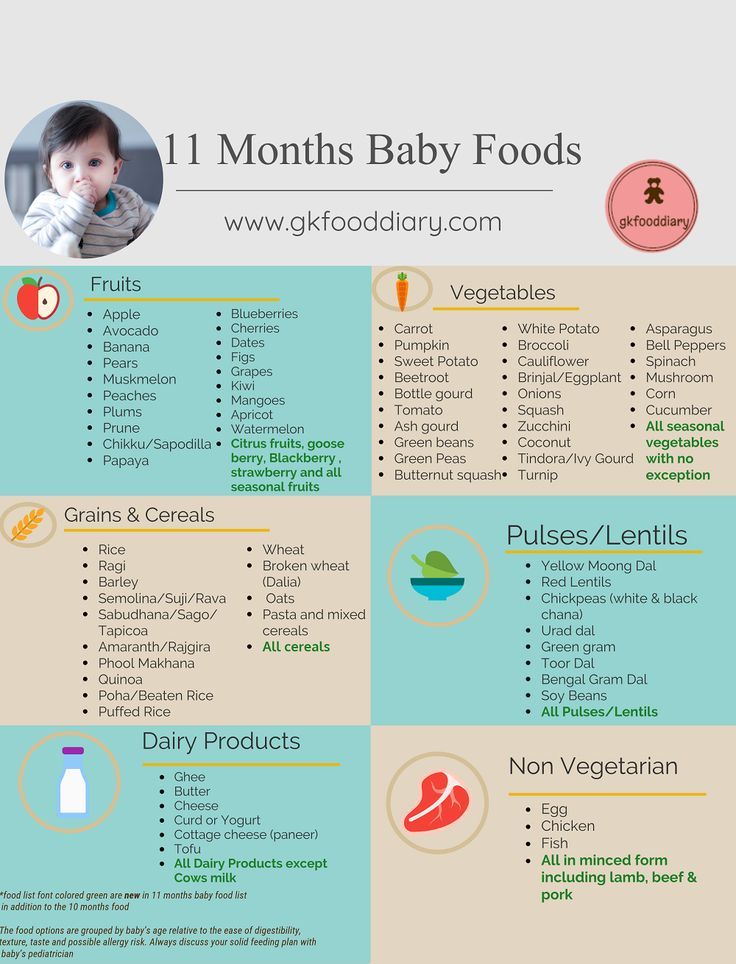 It’s great served as a meal itself or mixed with baby’s favorite fruit or vegetable puree. Baby food for 4-6 months and up – stage 1 baby food.
It’s great served as a meal itself or mixed with baby’s favorite fruit or vegetable puree. Baby food for 4-6 months and up – stage 1 baby food.
Medically reviewed by Jamie Johnson, Registered Dietitian Nutritionist (RDN)
Baby cereal doesn’t have to be plain and boring 🙅♀️!
No way! Not for our adventurous babies!
Not only do we want a delicious tasting baby cereal, but we also want it to be loaded with nutrients to help our growing babies. Are we asking too much? I don’t think so!
Enter – our trusted superfood grain – quinoa 👏!
First time making homemade baby food? Then, I would suggest that you start by reading my very in-depth Guide on how to Make Homemade Baby Food – which goes over all the important information such as the best cooking tools to have on hand, safe storage, how to know when baby is ready for solids, how to introduce purees, the best first foods for baby, and more! You can also check out my best-selling cookbook for even more information and recipes!
Quinoa Baby Cereal Video
Watch this video to see how easy this recipe is to make for your baby!
REASONS TO LOVE THIS Quinoa Cereal- great baby food for 4+ months
- 1-ingredient
- super smooth and creamy
- delicious
- great for digestion
- easy to make – less than 20 minutes
- freezer-friendly
- budget-friendly
- homemade
- healthy
- organic – can easily use organic quinoa in this recipe
Quinoa is so healthy that it literally has superpowers!
- Protein: quinoa is a good source of protein for baby.
 It’s actually a complete protein, meaning it has all of the essential amino acids that our body cannot make on its own. Lysine is one of these, which is rare to find in a plant source. Protein helps support the growth and development of babies.
It’s actually a complete protein, meaning it has all of the essential amino acids that our body cannot make on its own. Lysine is one of these, which is rare to find in a plant source. Protein helps support the growth and development of babies. - Fiber: this ancient grain contains almost twice as much fiber as brown rice, which makes it great for babies’ sensitive digestive organs and helps things get going ‘down there’ in a gentle way.
- Iron: has a good amount of iron, which is especially important for babies around 6 months of age as their iron reserves start to diminish. Quinoa is a natural way to boost their reserves without using iron-fortified products.
- Magnesium: excellent source of magnesium, which aids in bone and teeth growth.
- Folate: quinoa has more folate than any other whole grain, which is important for making DNA and hemoglobin and for brain development.
Baby can have quinoa as one of their first foods. When a baby can start on solids is determined by their own rate of development, which generally comes between 4-6 months of age. Some of the developmental milestones babies need to reach in order to start solids include: if your baby has solid control of their head and neck, if your baby has doubled in weight, and if your baby is reaching for or opening their mouth when you eat (see my guide here). Before you start baby on purees, you should consult with your pediatrician to make sure your child is developmentally ready.
When a baby can start on solids is determined by their own rate of development, which generally comes between 4-6 months of age. Some of the developmental milestones babies need to reach in order to start solids include: if your baby has solid control of their head and neck, if your baby has doubled in weight, and if your baby is reaching for or opening their mouth when you eat (see my guide here). Before you start baby on purees, you should consult with your pediatrician to make sure your child is developmentally ready.
Besides all of the amazing health benefits from quinoa, it is also a super easy baby cereal to make.
- Cook: make a batch of your favorite quinoa.
- Blend: transfer the cooked quinoa into a blender or food processor. Add in a little water or other liquid to get the grains completely smooth.
- Serve: serve to baby by itself or paired with another fruit or veggie puree.

- Freeze: you can store this puree in the fridge for up to 4 days or you can freeze the cereal to use on another day.
Type of Quinoa to Use: I made this recipe using the trio color blend of quinoa, which has 3 different types of quinoa in it. But any color of quinoa will work with this recipe and usually, the white quinoa is the easiest to find in almost all grocery stores.
GREAT Quinoa COMBINATIONsWhile Quinoa Puree is great by itself, it’s also super easy to mix and match with other nutrient-dense baby food purees. Give these fun flavor combos a try!
- Apples
- Apricots
- Butternut Squash Baby Food
- Bananas
- Sweet Potato
- Mashed Banana or Avocado
- Creamy Mango-licious Baby Food Puree
- The Best Broccoli Baby Food
- Carrot Puree Recipe for Baby (Stage 1)
- Pumpkin
- Yogurt
While the most popular option is adding cinnamon to baby cereal, you can also add in a pinch of cloves, nutmeg, cardamom or pumpkin pie spice.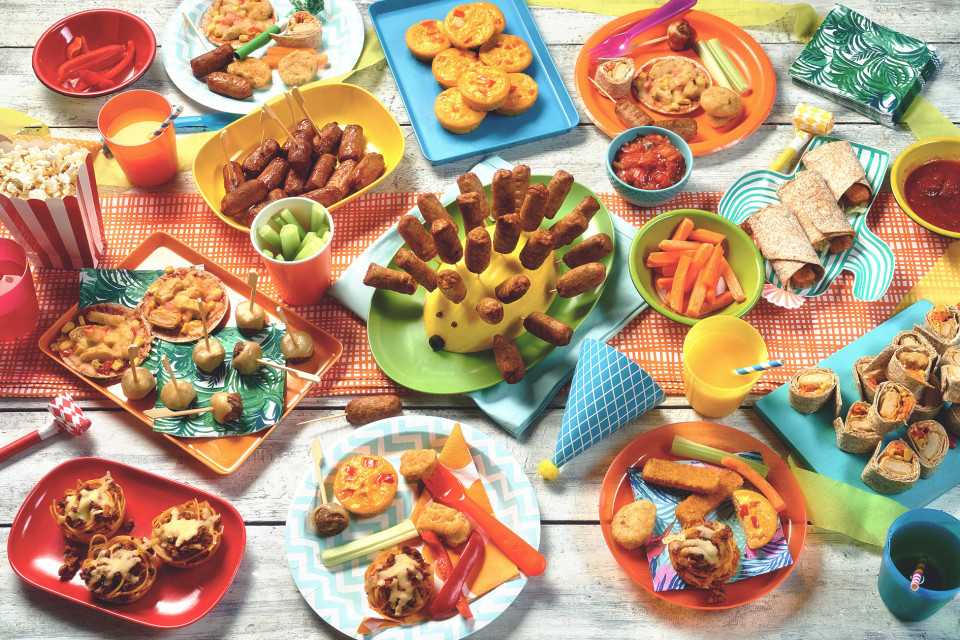
Tip on Spices: I always added spices to my baby food purees, but you can add or leave out spices in all of your baby food. You do you! Either way, this puree will taste amazing.
HOW TO STORE Quinoa Cereal REFRIGERATORYou can store in an airtight container in the fridge for 3-4 days.
FREEZERThis puree can be frozen for up to 4 months.
- Spoon puree into a freezer storage container (this is my favorite freezer storage container) – do not overfill.
- Place the lid on the storage container or cover with a piece of saran wrap and label with date and recipe name.
- Place the tray into the freezer and let freeze completely – preferably overnight.
- Pop-out the baby food cubes and place in a zip-lock baggie or stasher bag – don’t forget to re-label the baggie or stager bag for future reference.
Need more information on how to store your baby foods – head over to my Best Baby Food Storage Containers – Plus 6 Tips on Freezing and Thawing post!
Tools Needed- Medium Saucepan
- Blender or Food Processor
- Freezer Tray
- Storage Containers for Fridge
- Stasher Bag
Favorite Kitchen Tools: Get a list of my favorite kitchen tools to make the best baby food here!
DID YOU MAKE THIS QUINOA BABY CEREAL?I’D LOVE TO KNOW HOW IT TURNED OUT! LEAVE A COMMENT AND A ⭐️ RATING BELOW 👇
- 1 cup water, low sodium broth or bone broth
- 1/2 cup quinoa (see notes)
- extra liquid for blending
Cook: In a small saucepan, bring the liquid to a boil. Add quinoa and stir. Reduce to a simmer, cover and cook for 12 minutes. Take off of heat, and let sit for 5 minutes.
Puree: Transfer the quinoa to a blender or food processor and puree for 2 minutes for a completely smooth puree or pulse for 1 minute for a chunky puree. If the puree is too thick, you may need to add in additional liquid. Start by adding in 1/4 cup of liquid at a time until you reach your desired consistency. I added 1/4 cup of water to get the perfect consistency for me (what you see in the photos).
Serve: let cool and serve to baby or spoon into a storage tray and freeze for future use.

Age: 4-6 months and up
Yield: roughly 25 ounces
Note on Quinoa: I used a trio blend of quinoa for this recipe, but you can use any color quinoa that you would like.
Storage: Fridge – store in an airtight container in the fridge for up to 4 days or in the freezer for up to 4 months.
Adding Spices: you can add a pinch of cinnamon, cloves, nutmeg, allspice or pumpkin pie spice while blending.
Did you make this recipe?
Tag @babyfoode on Instagram and hashtag it #babyfoode!
Pin Recipe Email a Friend
Complementary food menu.
 Complementary feeding by months
Complementary feeding by months There is a need to introduce new products and dishes into his diet, different in their nutritional and biological value, composition, texture and taste. The introduction of complementary foods is an important and crucial moment in organizing the proper feeding of a child in the first year of life, so the approach to it must be responsible and reasonable. The expansion of the child's nutrition is caused by the need to additionally introduce a number of nutrients into his body, the intake of which only with human milk or an adapted mixture becomes insufficient at a certain stage in the development of the child's body. In particular, the child's body needs proteins, fats, carbohydrates, dietary fiber, a wide range of minerals and trace elements necessary for its further growth and development. Many children, especially in winter and spring, begin to experience a deficiency of certain vitamins.
Introduce complementary foods earlier than 3-4 months. inappropriate, since the child's body is not yet ready for this. In addition, early complementary feeding may reduce the frequency and activity of suckling and thus crowd out breastfeeding. At the same time, introducing complementary foods after 6-7 months is also not advisable, because this may cause problems with the perception of denser food, various negative reactions, up to reflex vomiting on solid food particles and the development of deficient conditions.
inappropriate, since the child's body is not yet ready for this. In addition, early complementary feeding may reduce the frequency and activity of suckling and thus crowd out breastfeeding. At the same time, introducing complementary foods after 6-7 months is also not advisable, because this may cause problems with the perception of denser food, various negative reactions, up to reflex vomiting on solid food particles and the development of deficient conditions.
Rules for the introduction of complementary foods
In order for the introduction of complementary foods to go smoothly, the following rules must be followed.
1. You can start the introduction of any new product only when the child is healthy.
2. Complementary foods should not be introduced during the hot season, as well as during preventive vaccinations.
3. During the period of introducing complementary foods, breast milk (adapted milk formula) remains the main type of nutrition for the child.
4. A new product or a new dish should be given in the morning in order to be able to note a possible reaction to it.
5. Complementary foods are given before breastfeeding (adapted formula).
6. Complementary foods must be given from a spoon, and not through a nipple.
7. Complementary foods begin to be given in a semi-liquid (homogenized) consistency, then the food becomes more dense.
8. The introduction of a new product (dish) begins with small quantities with a gradual increase in volume.
9. Complementary foods must begin with one type of product of this group with the gradual inclusion of new ones.
10. As complementary foods, it is better to use industrial products that have a stable composition and are made from environmentally friendly raw materials.
For each baby, the timing of the introduction of complementary foods is individual. As a rule, the first complementary foods coincide with the age of 5. 5-6 months and do not prevent further breastfeeding or artificial feeding.
5-6 months and do not prevent further breastfeeding or artificial feeding.
juices are the first to be introduced into the child's diet. Juices are a source of sugars, potassium, iron, β-carotene. They can be monocomponent (from one type of fruit) and polycomponent, consisting of 2 or more fruits, berries or vegetables. They may be clarified or contain pulp. The nutritional value of juices with pulp is higher. First, monocomponent clarified juices (preferably apple, pear), without sugar are introduced. The sweetness in these juices is achieved by selecting sweet fruits containing natural sugars. They begin to introduce juices from 4–4.5 months with ½ tsp. and gradually, in the absence of a reaction, increase the amount; from 5.5 months you can enter polycomponent juices. For children suffering from unstable stools, it is best to give juices from blueberries, blackcurrants, cherries, pomegranates, which contain tannins and act as a fixative. Cabbage and beetroot juices, prunes nectar, which act as a laxative, are very useful for children with constipation.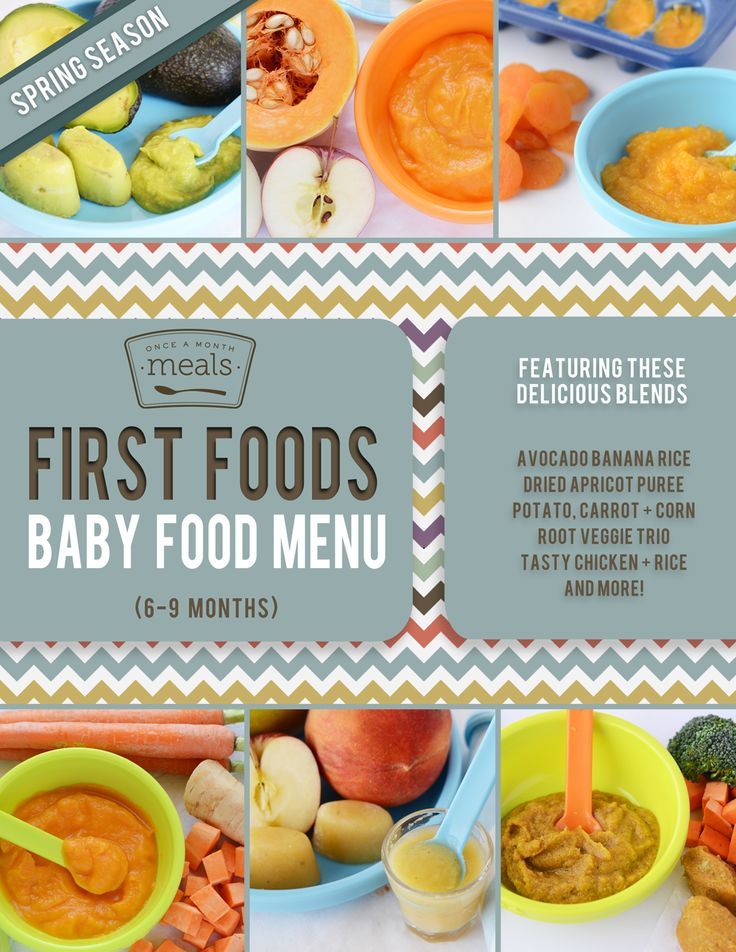
2 weeks after the administration of juices, fruit purees are prescribed. They can be monocomponent or multicomponent, as well as combined, when dairy additives (cottage cheese, yogurt, cream) or grain additives (specially processed rice, corn, oatmeal) are added to their composition. Fruit purees are also divided according to the degree of grinding: homogenized for children aged 4–6 months. and puree for children 6-9 months. Fruit purees are a source of natural sugars, vitamin C, β-carotene, potassium, iron, bioflavonoids that increase the activity of the immune system. Fruit purees, as well as juices with pulp, contain dietary fiber that regulates intestinal motility. They participate in the normalization of the intestinal microflora and are able to remove toxic substances from the body. With an unstable stool, it is better to use puree from apples, pears, bananas, rich in pectins, which have a beneficial effect on digestion. With a tendency to constipation, apricot, plum, carrot, prunes puree is recommended.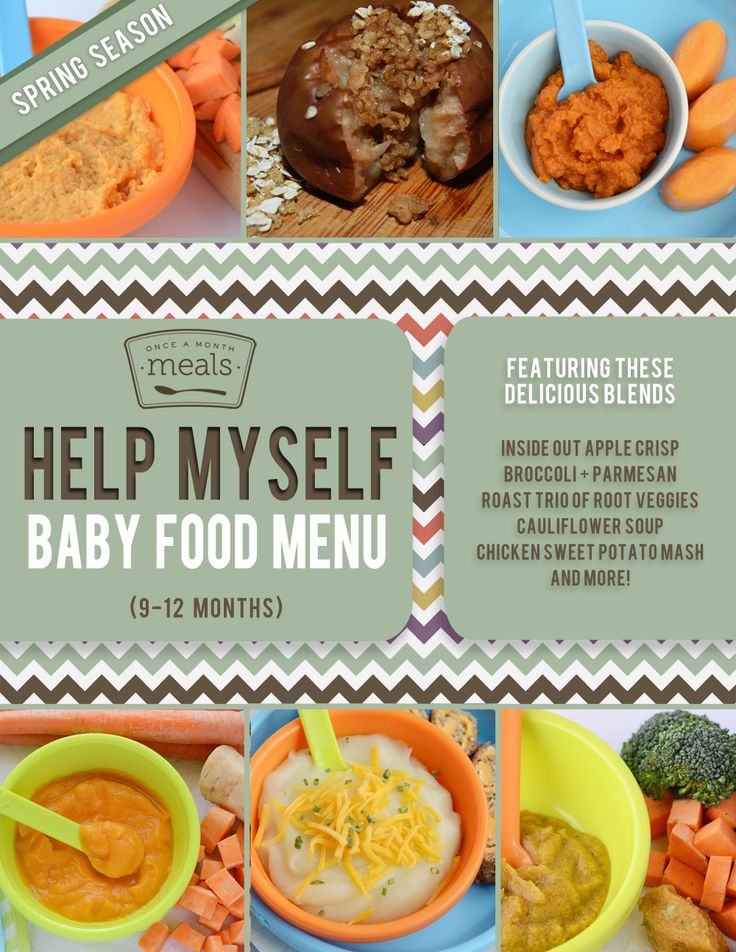 The latter is given in addition to other fruit purees from 2 to 4 teaspoons per day.
The latter is given in addition to other fruit purees from 2 to 4 teaspoons per day.
From 5–6 months, more dense food is introduced into the child's diet - main complementary foods . The need for the introduction of complementary foods is due to the peculiarities of the development of the child. After four months of life, his neuropsychic development is proceeding at a rapid pace. The kid becomes more active, mobile, keenly interested in the world around him. Therefore, he no longer needs only breast milk or formula, as well as those small amounts of nutritional supplements in the form of fruit juices and purees. Complementary foods are given in fairly large quantities and are actually independent nutrition, almost completely replacing first one and then several breastfeeds or formula. If the baby is breastfed, after each meal, it should be applied to the mother's breast. This creates the prerequisites for a longer preservation of lactation.
There are various special programs that provide for the gradual introduction of various complementary foods into the child's diet. The choice of the first product of the main complementary foods is carried out taking into account the state of the digestive system and the developmental features of the child. For children with low body weight, single regurgitation, episodic colic and flatulence, as well as absolutely healthy babies, cereals (grain complementary foods) can be recommended as the first complementary foods. At present, cereals industrial production, which are prepared from environmentally friendly raw materials, using modern technologies, which improves their absorption. They have a stable composition, good taste and guaranteed microbiological parameters. Porridges are enriched with vitamins and minerals necessary for the growing body of a child and are of great importance for the prevention of a number of alimentary-dependent diseases, such as anemia, rickets, malnutrition, which often occur in children in the second half of life. One of the advantages of instant cereals is the possibility of their quick preparation, without boiling.
The choice of the first product of the main complementary foods is carried out taking into account the state of the digestive system and the developmental features of the child. For children with low body weight, single regurgitation, episodic colic and flatulence, as well as absolutely healthy babies, cereals (grain complementary foods) can be recommended as the first complementary foods. At present, cereals industrial production, which are prepared from environmentally friendly raw materials, using modern technologies, which improves their absorption. They have a stable composition, good taste and guaranteed microbiological parameters. Porridges are enriched with vitamins and minerals necessary for the growing body of a child and are of great importance for the prevention of a number of alimentary-dependent diseases, such as anemia, rickets, malnutrition, which often occur in children in the second half of life. One of the advantages of instant cereals is the possibility of their quick preparation, without boiling. The range of industrial cereals is quite wide and involves the use of various cereals: buckwheat, oatmeal, rice, barley, corn, etc. Porridges are made from one type of cereal (monocomponent), and using 2 or more cereals (polycomponent).
The range of industrial cereals is quite wide and involves the use of various cereals: buckwheat, oatmeal, rice, barley, corn, etc. Porridges are made from one type of cereal (monocomponent), and using 2 or more cereals (polycomponent).
There are gluten-containing cereals (semolina, oatmeal, barley) and gluten-free (buckwheat, corn, rice). It is not recommended to introduce gluten-containing cereals into the child's diet before 6 months of age. This is a preventive measure for the occurrence of allergic reactions to gluten, as well as early manifestations of celiac disease. Porridges can be dairy or dairy-free. The latter are diluted with breast milk or infant formula received by the child. They are especially necessary for children who are allergic to cow's milk proteins and lactase deficiency. In the future, gluten-containing cereals (oatmeal, barley, wheat, semolina) and cereals from a mixture of cereals can be used.
There are also varieties of cereals. These primarily include soluble biscuits. For its preparation, wheat, oat flour is used, with the addition of various food ingredients (milk, sugar, malt extract, corn starch, egg yolk, etc.). An obligatory component of instant biscuits are vitamins especially necessary for a child (groups B, C, beta-carotene) and minerals (calcium, phosphorus, iron). Instant biscuits can usually be used from 5 months. both in its natural form, which contributes to the formation of the act of chewing, and in the form of cereals, which is especially convenient in road conditions.
For its preparation, wheat, oat flour is used, with the addition of various food ingredients (milk, sugar, malt extract, corn starch, egg yolk, etc.). An obligatory component of instant biscuits are vitamins especially necessary for a child (groups B, C, beta-carotene) and minerals (calcium, phosphorus, iron). Instant biscuits can usually be used from 5 months. both in its natural form, which contributes to the formation of the act of chewing, and in the form of cereals, which is especially convenient in road conditions.
With increased body weight or delayed stools (difficult defecation), vegetable puree can be offered as a starting complementary food from 4–6 months of age. Vegetable puree is a source of organic acids, potassium, iron and dietary fiber, including pectins. Certain types of vegetables (carrots, pumpkin, spinach, etc.) are rich in beta-carotene, a precursor of vitamin A. At the beginning, vegetable puree should consist of one type of vegetable with delicate fiber, such as zucchini. Further, it is advisable to use a combination of 3-4 vegetables. Vegetable purees can be monocomponent (cauliflower, zucchini, carrots, etc.) and polycomponent (cauliflower and pumpkin, or zucchini, carrots and potatoes). Multicomponent purees can contain not only various vegetables, but also a combination with fruits (apple-carrot, pumpkin-apple, etc.). Multicomponent vegetable purees are richer in the spectrum of nutrients and therefore more useful, but it is recommended to introduce them after no negative reactions to individual vegetables have been noted (monocomponent vegetable purees). There are also combined vegetable purees, when meat (vegetable-meat) or fish (vegetable-fish) is added to vegetables. Vegetable purees, depending on the age of the child, come in 3 degrees of grinding: homogenized, puree and coarsely ground.
Further, it is advisable to use a combination of 3-4 vegetables. Vegetable purees can be monocomponent (cauliflower, zucchini, carrots, etc.) and polycomponent (cauliflower and pumpkin, or zucchini, carrots and potatoes). Multicomponent purees can contain not only various vegetables, but also a combination with fruits (apple-carrot, pumpkin-apple, etc.). Multicomponent vegetable purees are richer in the spectrum of nutrients and therefore more useful, but it is recommended to introduce them after no negative reactions to individual vegetables have been noted (monocomponent vegetable purees). There are also combined vegetable purees, when meat (vegetable-meat) or fish (vegetable-fish) is added to vegetables. Vegetable purees, depending on the age of the child, come in 3 degrees of grinding: homogenized, puree and coarsely ground.
From 5–6 months, cottage cheese is introduced into the child's diet, which is a source of complete protein and calcium. Cottage cheese is introduced into the child's diet from small amounts. Gradually increase the dose and after 3-4 days bring it up to 20 g per day in one or two doses, then up to 40 g and by the year - up to 50 g per day. They give cottage cheese specially prepared for baby food in dairy kitchens or in baby food shops of dairy factories.
Gradually increase the dose and after 3-4 days bring it up to 20 g per day in one or two doses, then up to 40 g and by the year - up to 50 g per day. They give cottage cheese specially prepared for baby food in dairy kitchens or in baby food shops of dairy factories.
From 6 months, you can enter egg yolk . From 6 months - ¼, from 8 months. - ½ hard-boiled egg yolk. It must be carefully separated from protein, which is not given to children under 1 year old, as it is difficult to digest. The yolk can be given simultaneously with milk porridge or vegetable puree. However, children with food allergies should not be given yolk, as ovalbumin is a strong allergen. Meat is recommended to be introduced into the child's diet from 7 months with natural feeding and from 6 months with artificial feeding. In some cases, if the child lags behind in development, there are manifestations of rickets, anemia, meat can be given earlier (at 5.5 and even 5 months at the same time as vegetable puree).
Canned meat is a valuable source of: animal protein, iron, magnesium, B vitamins, including B12. Canned meats come in three degrees of grinding: homogenized (with a particle size of 0.4 mm), puree (with a particle size of 1.5 mm) and coarsely ground (with a particle size of 3 mm). Some manufacturers produce canned food in the form of meatballs, with vegetables, i.e. there is a formed dish. Canned meat can be monocomponent, multicomponent and combined, with vegetable raw materials (cereals or vegetables).
From 8–9 months vegetable soups can be introduced into the child's diet. Meat broths are currently not used in the nutrition of children under 1 year of age, as they mainly contain substances that cause irritation of the gastric mucosa. Soups are used as the first course when the child is already preparing lunch. They are given in a small amount of 30-50 ml to stimulate the function of the digestive glands and increase appetite. The small volume of the 1st dish is due to the importance of providing the child with the 20th dish in the required volume, as it is more complete in terms of nutrient content.
Expert advice:
- Take your time with the introduction of complementary foods. The baby's body is designed so that up to 4-6 months he can only digest mother's milk or adapted mixtures, and other products are unacceptable for him. That is why it is necessary to introduce new food very carefully, giving the child's body the opportunity to get used to it.
- With mixed and artificial feeding, it is recommended to introduce complementary foods two weeks earlier than with exclusive breastfeeding.
- Up to a year and a half, it is better to introduce each new juice with caution and in no case give the baby multicomponent juices until the child's reaction to each juice of the components of such a drink has been studied.
- Alternate complementary foods according to the nature of the products - if vegetables were the first complementary food, then it is better to choose cereals as the second.
- If you prepare complementary foods yourself, do not do it for the future - all food for the baby should be fresh.

- Up to 1.5 years, it is categorically not recommended to add salt and sweeten the child's food. Sodium salt is poorly excreted and accumulates in the body, besides, the child's kidneys are not yet sufficiently developed. Sugar, on the other hand, contributes to the development of caries in milk teeth, loads the pancreas and forms the habit of sweets in the baby.
Sample daily diet for a 6 month old baby
| Feeding hour | Menu composition | Approximate amount g/ml |
| 06:00 | Breast milk or formula | 180–200 |
| 10:00 | Breast milk or formula fruit puree | 180 fifty |
| 14:00 | vegetable puree Fruit juice | 100 fifty |
| 18:00 | Breast milk or formula Cottage cheese Fruit juice | 180 twenty twenty |
| 22:00 | Breast milk or formula | 180–200 |
Example of a daily diet for a child aged 8-9 months
| Feeding hour | Menu composition | Approximate amount g/ml |
| 06:00 | Breast milk or formula | 200 |
| 10:00 | Porridge Fruit juice | 170 fifty |
| 14:00 | vegetable puree Yolk Or meat puree Fruit juice | 170 ¼ pcs. fifty 400 |
| 18:00 | Kefir or baby milk Cottage cheese fruit puree | 180 40 60 |
| 22:00 | Breast milk or formula | 200 |
Sample daily diet for a 1 year old child
| Feeding hour | Menu composition | Approximate amount g/ml |
| 08:00 | Milk porridge fruit puree Fruit juice | 200 thirty fifty |
| 12:00 | Vegetable broth with croutons vegetable puree steam cutlet Fruit or vegetable juice | 30/10 150 60 thirty |
| 16:00 | Kefir Cottage cheese fruit puree | 100 100 fifty |
| 20:00 | Vegetable puree or porridge Baby milk fruit puree | 100 100 fifty |
| 24:00 | Kefir or baby milk | 200 |
If the child continues to receive breast milk, then each feeding should end with the attachment of the baby to the mother's breast. At night, in this case, the child receives only the mother's breast. As a rule, after the introduction of all types of complementary foods into the diet of a child, it is possible to gradually wean him from the breast. However, it is not recommended to stop breastfeeding even after the full introduction of all types of complementary foods in the hot summer, when there is a high risk of developing intestinal diseases, and also if the child has any health problems. With sufficient lactation (if desired), even a completely healthy child can continue breastfeeding up to 1.5–2 years.
At night, in this case, the child receives only the mother's breast. As a rule, after the introduction of all types of complementary foods into the diet of a child, it is possible to gradually wean him from the breast. However, it is not recommended to stop breastfeeding even after the full introduction of all types of complementary foods in the hot summer, when there is a high risk of developing intestinal diseases, and also if the child has any health problems. With sufficient lactation (if desired), even a completely healthy child can continue breastfeeding up to 1.5–2 years.
#PROMO_BLOCK#
Learn more about formula feeding on our blog.
Feeding table. Sample menu
5.5 months
Breakfast
Vegetable mono puree: zucchini, cauliflower, broccoli, potatoes, carrots. Start with 5 g (teaspoon), work up to 50 g.
6 months
Breakfast
Vegetable puree (mono) - from 50 to 100 gr.
Vegetable oil - 1 gr.
Snack
Fruit puree (single product). Apple, pear, banana. From 5 - to 30 g
6.5 months
Breakfast
Porridge (without gluten, milk, sugar): buckwheat, oatmeal, corn, rice. From 10 - to 50 g
You can start with your expressed milk, or you can use fruit juice diluted with water by 50%.
Artificial workers can immediately buy milk porridge
7
LunchVegetable puree (you can make mixed vegetables) - 100 g
Vegetable oil - 2 g
7
Fruit mono puree - 30-40 g
7 months
breakfast 0003
Vegetable puree - 150 g
Vegeted oil - 3 g
SUPPLE
Fruit puree (you can mixed) - 40-50 g
Dinner
CD - 5-10 g - 5-10 g
7.
 5 months
5 months breakfast
Porridge (millet/multi -zhlakaya) - 150 g
butter - 2 g
Fruit or vegetable juice - 30 g
Dinner 9048 Dinner 449
Vegetable puree - 150 g
Vegetable oil - 3 g
Yolk (quail) - 14 - 3 times a week
SUPPOCE
Fruit puree - 70 g
9000 90000
DIARCottage cheese - 20-30 g
Instant baby biscuits
8 months
Breakfast
Porridge - 150 g
Butter - 3 g
Juice - up to 50 g
Lunch
Vegetable puree - 150 g. You can add green peas and beans puree.
Vegetable oil - 5 g
Yolk (quail egg) - 12 pcs. - 3 times a week.
Puree meat (mon) - from 5 to 20 g
7
POLYFruit puree - 70 g
Cookies
Dinner 0 9000
COMROD - 40 g
KOMITRODI drink - 10-20 g
8.
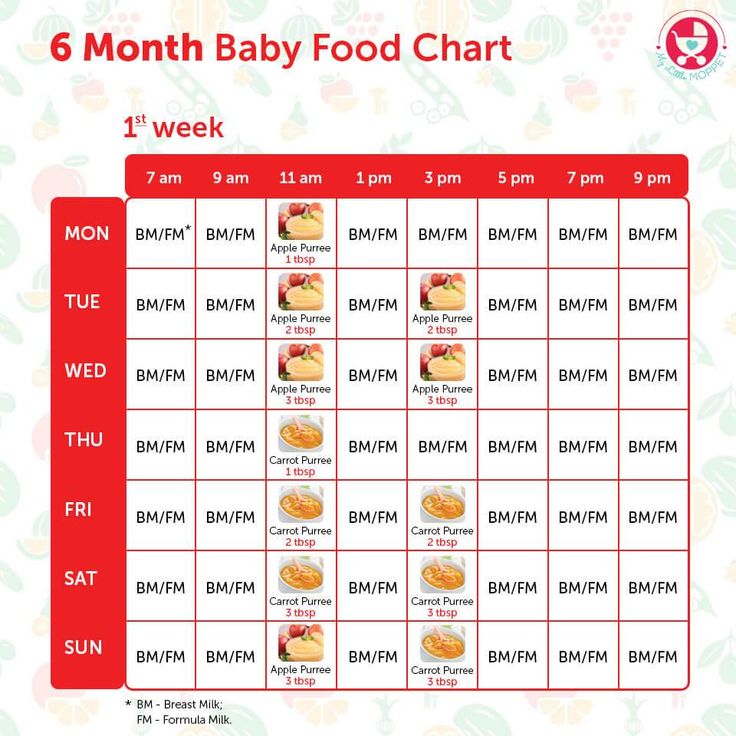 5 months
5 months breakfast Vegetable puree - 170 g
rast. butter - 5 g
Yolk 1/2 every other day
Meat puree - up to 30 g
Snack
Fruit puree - 70 g
450
Cottage cheese - 40 g
Kefir - up to 50 g
Cookies, crackers, wheat bread
9 months
Breakfast
Milk porridge - 180 g
Butter - 5 g
Lunch
Vegetable puree - 180 g per day
Rast. butter - 5 g
Meat puree - 50 g
Yolk (quail egg) 1/2 every other day
SUPPORTION
Fruit puree - 80 g
You can bake apple
Dinner
G
KEFIRS - 80 g 9000 G
LES, Sukhiri, Sukhiri.
10-12 months
Breakfast.
Milk porridge - 200 g
Butter - 5 g
Juice - 100 ml per day
Wheat bread.